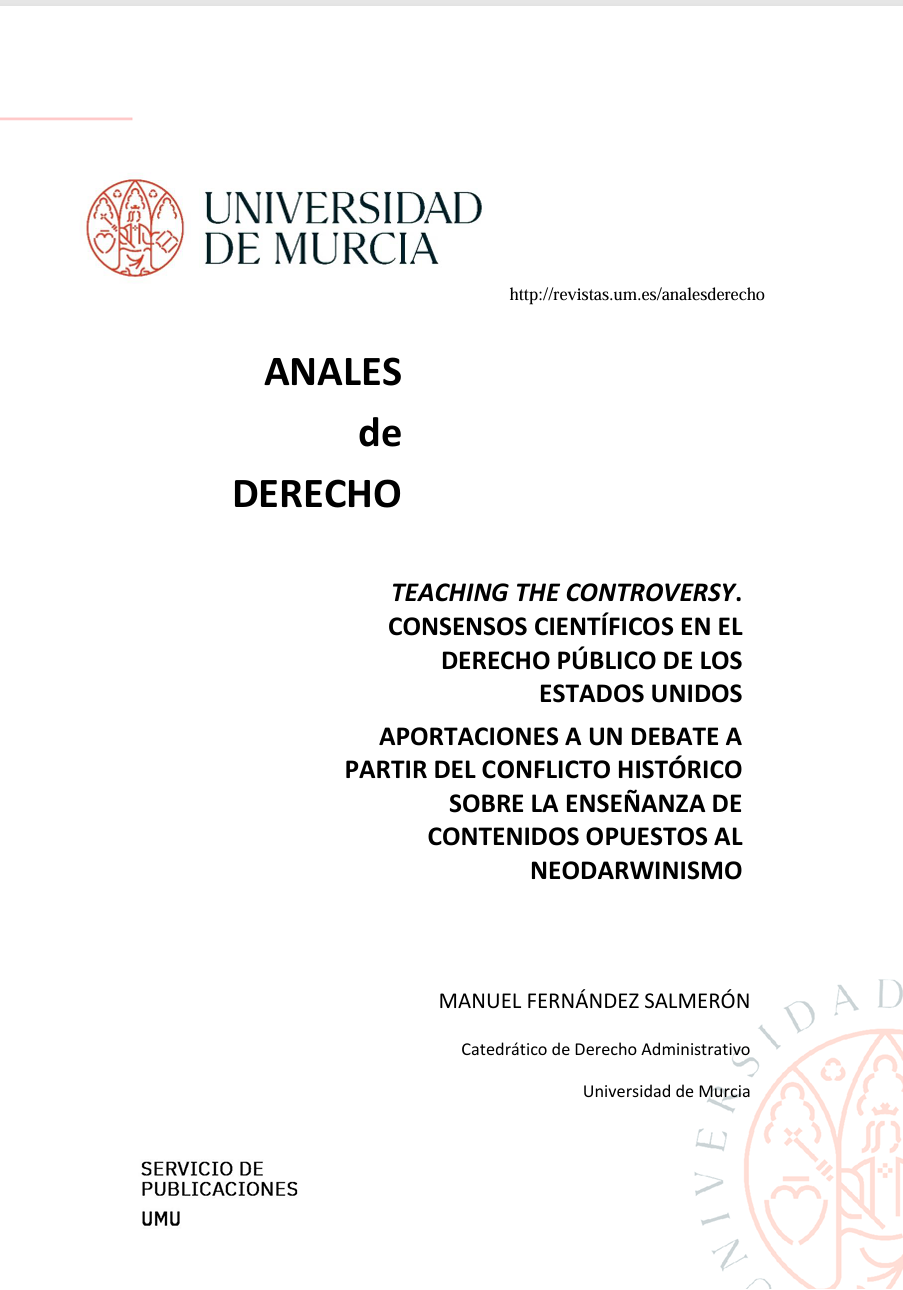Teaching the controversy”. Scientific Consensus in American Public Law
Contributions to a debate based on the historical dispute about the teaching of contents conflicting with neo-Darwinism
Supporting Agencies
Abstract
The article addresses a set of reflections about the role of Law regarding scientific consensus, seizing for this purpose a problematic exposition on the main milestones of the expulsion process of any explanatory proposal about the biological origin of mankind in conflict with the postulates of Neo-Darwinism in the educational system of the United States. The conclusions reveal a congenital weakness of the rule of law to face certain socially rooted conceptions about the conclusions provided by scientific knowledge. Specifically, explanatory gaps have been found in American law regarding the lack of granting on alternative explanations to students, where scientific conclusions show signs of exhaustion or clear explanatory limits. Likewise, conclusions are shown about some possible inconsistencies of the courts regarding the interpretation of some affected constitutional clauses (such as the Establishment clause), as well as on the influence of rhetoric and narratives over the entire science system and its impact on the subject studied.
Downloads
References
ARNOLD, A., Climate Change and Storytelling: Narratives and Cultural Meaning in Environmental Communication, Switzerland, Palgrave Macmillan, 2018.
BING, A.D., “Evolution, Creationism and the Religion Clauses”, Albany Law Review, núm. 46, 1982.
CAUDILL, D.S., “Scientific Narratives in Law: An Introduction”, Law & Literature, núm. 14, 2002, pp. 253-274.
CAUDILL, D.S., Stories About Science in Law: Literary and Historical Images of Acquired Expertise, Ashgate Publishing Limited, 2011.
COLLADO GONZÁLEZ, S., “Teoría del Diseño Inteligente (Intelligent Design)”, en Fernández Labastida, F. y Mercado, J.A. (Eds.), Philosophica: Enciclopedia filosófica on line, I. 2008; disponible en: https://www.philosophica.info/archivo/2008/voces/diseno_inteligente/Diseno_inteligente.html.
COLLADO GONZÁLEZ, S., “Panorámica del debate creacionismo-evolucionismo en los últimos cien años en USA”, Anuario de Historia de la Iglesia, XVIII, 2009, pp. 47-48; disponible en: https://dialnet.unirioja.es/descarga/articulo/2958568.pdf.
DAVIS, P. y KENYON, D.H., Of Pandas and People: The Central Question of Biological Origins. 2nd ed., Charles B. Thaxton ed., Haughton Publg. Co, 1993.
DE TOCQUEVILLE, A., Democracy in America, The University of Chicago Press, 2000.
DEWOLF, D.K., WEST, J.G. y LUSKIN, C., “Intelligent Design Will Survive Kitzmiller v. Dover”, Montana Law Review, núm. 68, 2007.
DEWOLF, D.K., WEST, J.G. y LUSKIN, C., “Rebuttal to Irons”, Montana Law Review, núm. 68, 2007.
DHOOGE, L.J., “From Scopes to Edwards: the sixty-year evolution of biblical creationism in the public school classroom”, University of Richmond Law Review, núm. 22, 1988.
EDMOND, G., “Negotiating the Meaning of a Scientific Experiment during a Murder Trial and Some Limits to Legal Deconstruction for the Public Understanding of Law and Science”, Sydney Law Review, núm. 20, 1998, pp. 361-401.
ELLIOT, D. (et altri), “Science, Agencies, and the Courts: Is Three a Crowd?, Environmental Law Reporter, News & Analysis, núm. 31, 2001.
ESTEVE PARDO, J., El desconcierto del Leviatán. Política y Derecho ante las incertidumbres de la Ciencia, Madrid, Marcial Pons, 2009.
GALLOWAY, R.W., “Basic establishment clause analysis”, Santa Clara Law Review, núm. 29, 1989.
GIBBENS, D.G., “Public School Education about Beginnings: Creationism, No! Truth about Science, Yes!”, Oklahoma Law Review, núm. 55, 2002.
GREENAWALT, K., Does God Belong in Public Schools?, Princeton University Press, 2005.
HANAKAHI, W.F., “Evolution-Creationism Debate: Evaluating the Constitutionality of Teaching Intelligent Design in Public School Classrooms”, University of Hawai’i Law Review, 25/9, 2002.
HERCE, R., “Monogenismo y poligenismo. Status Quaestionis”, Scripta theologica, núm. 46, 2014, pp. 105-120; disponible en: https://www.unav.edu/documents/6709261/7026503/monogenismoypoligenismo.pdf.
IRONS, P., “Disaster in Dover: The Trials (and Tribulations) of Intelligent Design”, Montana Law Review, núm. 68, 2007.
JASANOFF, S. y NELKIN, D., “Science, Technology, and the Limits of Judicial Competence”, American Bar Association Journal, núm. 68-9, 1982, pp. 1094-1099.
LACADENA, J-R., “Creacionismo y Diseño inteligente frente a Evolucionismo en los Estados Unidos”, Pliego, 2515, 22 de abril de 2006; disponible en: https://www.vidanuevadigital.com/wp-content/uploads/2008/02/vn2515_pliego.pdf.
MACDONALD, B., “Creationism and Intelligent Design”, Dalhousie Journal of Legal Studies, 18, 2009.
OLESKIN, A.V. y MICKUNAS, A., Biopolitics: The Political Potential of the Life Sciences, Nova Science Publishers, Inc., New York, 2012.
PARRILLA MARTÍNEZ, D., “El neotomismo norteamericano ante el ‘diseño inteligente’”, 2018 [blog]; disponible en: https://blogs.comillas.edu/FronterasCTR/?p=2957.
POPPER, K., Conjectures and Refutations: The Growth of Scientific Knowledge, Basic Books, New York, 1965.
RADAN, P., “Is Intelligent Design Science? Who Decides If It Is?”, Macquarie Law Symposium, 2006.
SESÍN, D., “El control judicial de la discrecionalidad administrativa”, Documentación administrativa, núm. 269-270, 2004, pp. 87 y ss.
SCOTT, E.C. y MATZKE, N.J., “Biological design in science classrooms”, Proceedings of the National Academy of Sciences of the United States, núm. 104, May 15, sup. 1, 2007, pp. 8669-8676; disponible en: https://www.pnas.org/content/pnas/104/suppl_1/8669.full.pdf.
WEXLER, J.D., “Kitzmiller and the ‘Is it science?’ Question”, First Amendment Law Review, núm. 5, 2006.

Copyright (c) 2025 Manuel Fernández Salmerón

This work is licensed under a Creative Commons Attribution-NonCommercial-NoDerivatives 4.0 International License.
The journal is object of publication in electronic and printed form. With the object of the first one, the author is supposed aware, being presumed that he lends his consent to such form of publication by the circumstance of presenting his manuscript. At the time of the printed edition the author will receive, of free form, 25 offprints of his contribution.
